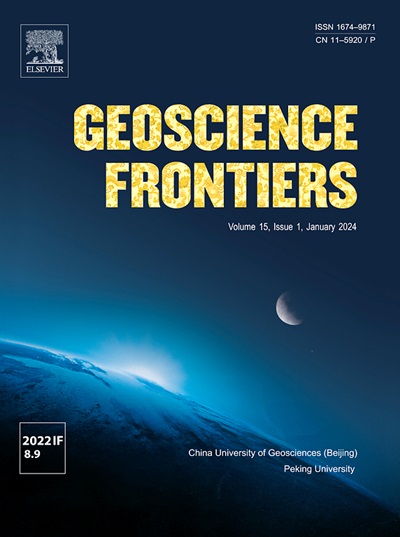Detailed in-depth mapping of the world largest anorthositic complex: Magnetic anomalies, 2.5-3D modelling and emplacement constraints of the Kunene Complex (KC), SW Angola
IF 8.9
1区 地球科学
Q1 GEOSCIENCES, MULTIDISCIPLINARY
引用次数: 0
Abstract
The Kunene Complex (KC) represents a very large Mesoproterozoic igneous body, mainly composed of anorthosites and gabbroic rocks that extends from SW Angola to NW Namibia (outcropping 18,000 km2, NE-SW trend, and ca. 350 km long and up to 50 km wide). Little is known about its structure at depth. Here, we use recently acquired aerogeophysical data to accurately determine its hidden extent and to unravel its morphology at depth. These data have been interpreted and modelled to investigate the unexposed KC boundaries, reconstructing the upper crustal structure (between 0 and 15 km depth) overlain by the thin sedimentary cover of the Kalahari Basin. The modelling reveals that the KC was emplaced in the upper crust and extends in depth up to ca. 5 km, showing a lobular geometry and following a large NE-SW to NNE-SSW linear trend, presumably inherited from older Paleoproterozoic structures. The lateral continuation of the KC to the east (between 50 and 125 km) beneath the Kalahari Cenozoic sediments suggests an overall size three times the outcropping dimension (about 53,500 km2). This affirmation clearly reinforces the economic potential of this massif, related to the prospecting of raw materials and certain types of economic mineralization (Fe-Ti oxides, metallic sulphides or platinum group minerals). Up to 11 lobes have been isolated with dimensions ranging from 135.5 to 37.3 km in length and 81.9 to 20.7 km in width according to remanent bodies revealed by TMI mapping. A total volume of 65,184 km3 was calculated only for the magnetically remanent bodies of the KC. A long-lasting complex contractional regime, where large strike-slip fault systems were involved, occurred in three kinematic pulses potentially related to a change of velocity or convergence angle acting on previous Paleoproterozoic inherited sutures. The coalescent magmatic pulses can be recognized by means of magnetic anomalies, age of the bodies as well as the lineations inferred in this work: (i) Emplacement of the eastern mafic bodies and granites in a stage of significant lateral extension in a transtensional context between 1500 Ma and 1420 Ma; (ii) Migration of the mantle derived magmas westwards with deformation in a complex contractional setting with shearing structures involving western KC bodies and basement from 1415 Ma to 1340 Ma; (iii) NNW-SSE extensional structures are relocated westwards, involving mantle magmas, negative flower structures and depression that led to the formation of late Mesoproterozoic basins from 1325 Ma to 1170 Ma. Additionally, we detect several first and second order structures to place the structuring of the KC in a craton-scale context in relation to the crustal structures detected in NW Namibia.

详细深入绘制世界上最大的斜长岩杂岩:安哥拉西南部Kunene杂岩(KC)的磁异常、2.5-3D建模和侵位限制
Kunene杂岩(KC)是一个巨大的中元古代火成岩,主要由斜长岩和辉长岩组成,从安哥拉西南部延伸到纳米比亚西北部(露头面积为18,000 km2, NE-SW走向,长约350 km,宽可达50 km)。人们对它的深层结构知之甚少。在这里,我们使用最近获得的航空地球物理数据来准确地确定其隐藏程度并揭示其深度形态。对这些数据进行了解释和建模,以研究未暴露的KC边界,重建被喀拉哈里盆地薄沉积层覆盖的上部地壳结构(深度在0至15公里之间)。模拟结果表明,KC位于上地壳,延伸深度约5 km,呈小叶状几何,沿NE-SW至NNE-SSW的大线性趋势,可能继承了更古老的古元古代构造。在卡拉哈里新生代沉积物下,KC向东的横向延伸(在50至125公里之间)表明其总体尺寸是露头尺寸(约53,500平方公里)的三倍。这一确认明确加强了该地块的经济潜力,与原材料勘探和某些类型的经济矿化(铁钛氧化物,金属硫化物或铂族矿物)有关。根据TMI测绘显示的残体,已分离出11个裂片,长度为135.5至37.3公里,宽度为81.9至20.7公里。仅计算了KC的磁性残余体的总积为65184 km3。一个长期复杂的收缩状态,其中涉及大型走滑断层系统,发生在三个运动脉冲中,可能与先前古元古代继承的缝合线的速度或收敛角的变化有关。通过地磁异常、岩体年龄以及本工作推断出的岩浆线序,可以识别出聚结岩浆脉冲:(1)东部基性岩体和花岗岩的侵位处于1500 ~ 1420 Ma的张拉背景下的显著横向伸展阶段;(ii) 1415 ~ 1340 Ma期间,地幔源岩浆在含西KC体和基底的剪切构造的复杂收缩背景下向西迁移,并伴有变形;(3) 1325 ~ 1170 Ma, NNW-SSE伸展构造向西迁移,涉及地幔岩浆、负花构造和坳陷,形成晚中元古代盆地。此外,我们发现了几个一级和二级结构,将KC的结构置于克拉通尺度的背景下,与纳米比亚西北部探测到的地壳结构相关联。
本文章由计算机程序翻译,如有差异,请以英文原文为准。
求助全文
约1分钟内获得全文
求助全文
来源期刊

Geoscience frontiers
Earth and Planetary Sciences-General Earth and Planetary Sciences
CiteScore
17.80
自引率
3.40%
发文量
147
审稿时长
35 days
期刊介绍:
Geoscience Frontiers (GSF) is the Journal of China University of Geosciences (Beijing) and Peking University. It publishes peer-reviewed research articles and reviews in interdisciplinary fields of Earth and Planetary Sciences. GSF covers various research areas including petrology and geochemistry, lithospheric architecture and mantle dynamics, global tectonics, economic geology and fuel exploration, geophysics, stratigraphy and paleontology, environmental and engineering geology, astrogeology, and the nexus of resources-energy-emissions-climate under Sustainable Development Goals. The journal aims to bridge innovative, provocative, and challenging concepts and models in these fields, providing insights on correlations and evolution.
 求助内容:
求助内容: 应助结果提醒方式:
应助结果提醒方式:


